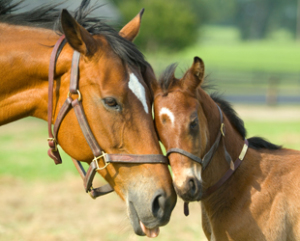By Brandi Holohan, DVM
 You’ve waited 11 long months … and your mare has just delivered her foal. Now what? The foal and mare are lying on the stall floor, staring at each other and trying to figure out what just happened. The first few hours of the relationship between mare and foal are extremely important for bonding and functioning as a maternal offspring pair.
You’ve waited 11 long months … and your mare has just delivered her foal. Now what? The foal and mare are lying on the stall floor, staring at each other and trying to figure out what just happened. The first few hours of the relationship between mare and foal are extremely important for bonding and functioning as a maternal offspring pair.
The mare generally stands within 15 minutes of delivery, and the tension on the umbilical cord will cause it to tear about 1 inch from the foal’s abdomen. The vessels in the cord are stretched, resulting in contraction and clotting. The placenta is sometimes passed immediately but more commonly will hang from the mare’s vulva for a short time. The umbilical stump on the foal’s belly should be dipped in antiseptic, dilute chlorhexidine, three times the first day, twice the second and once the third. If the umbilicus does not stop bleeding within a few minutes, or if it doesn’t break away from the placenta, tie it with dental floss or a clean shoe lace about 1 inch from the abdomen. Cut off any excess, leaving half an inch to an inch on the opposite side of the tie, and consult your veterinarian.
My general rule of thumb is 1-2-3: The foal should stand within one hour and nurse within two hours, and the mare should pass her placenta within three hours. Set the placenta aside for the veterinarian to inspect for completeness and any abnormalities. A retained placenta is an emergency.
Maiden mares often have a more difficult time adjusting to a nursing foal. The mare may require you to offer reassurance that the foal is OK and restrain her to allow the foal to nurse. If the mare was dripping milk for more than one hour prior to foaling, consult your vet. The foal needs to consume the colostrum/first milk from the mare in order to absorb the antibodies that are essential for survival. If the mare loses the colostrum prior to nursing, or the foal does not consume an adequate amount within the first six to eight hours, it may be at risk of life-threatening infection. Your veterinarian typically draws a blood sample when the foal is 18 to 24 hours of age to assess this antibody level, the IgG level. This test gives you the peace of mind that the level is adequate and the foal does not require a plasma transfusion.
Look over your new foal for any physical signs of concern. Start at the nose and work your way to the tail. The nostrils should be clear of debris. If you notice milk coming from the nostrils, call your vet. This may indicate a problem with the foal’s palate or ability to swallow correctly. Part the foal’s lips: The upper and lower jaw should be in good alignment, and the gums should be pink (not red). Look at the foal’s eyes. A new foal may have suffered some blood vessel rupture in the white part of the eye during the foaling process from pressure, and the eyes may look red around the edges. Discharge from the eyes, cloudiness, swelling and holding the eyes closed are causes for concern. Ears should be upright and alert. Legs should be strong and without angular deformities. The umbilicus should be checked for a hernia, swelling, any continued bleeding or urine drainage.
The foal should pass a blackish stool called meconium within the first 12 to 18 hours of life. Contact your veterinarian if the foal appears to be in discomfort or has not passed meconium. An enema to soften this stool and allow it to pass more easily may be needed.
Foals should be full of energy and curiosity, and nurse with vigor and frequency. If your foal seems dull or lethargic, it is an emergency and may indicate serious illness.
Your veterinarian will perform a mare and foal exam. The mare will be examined for foaling complications, vulvar or reproductive tract injuries, udder health, and post-foaling comfort. The foal will have a full physical exam and should have a blood sample taken for an IgG (antibody level), as previously discussed. As always, contact your veterinarian with questions or concerns. He or she can offer support as you and your mare welcome this new life into the world.


